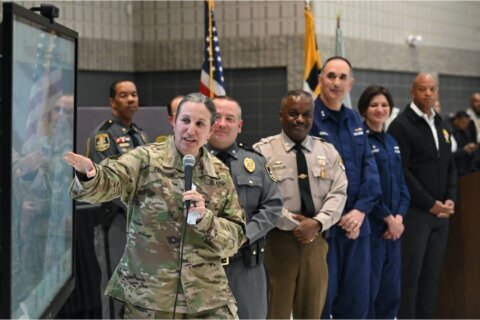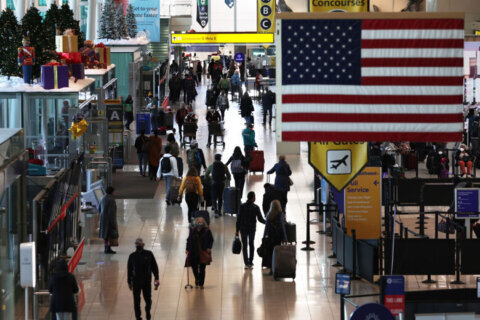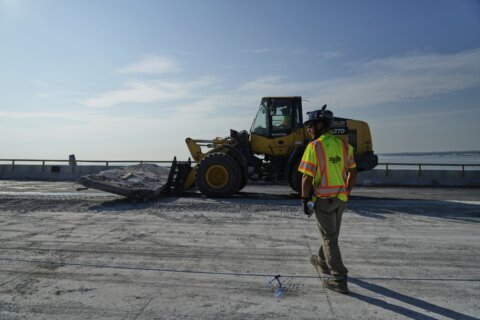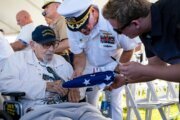
Tuesday marks four weeks since tragedy hit Baltimore, Maryland, and six lives were lost when a huge container ship slammed into the Key Bridge, causing most of the structure to collapse into the Patapsco River.
Dozens of people have been working around the clock to try and get the tens of thousands of tons of mangled wreckage such as steel and concrete removed from the top of the ship, named The Dali, and from the river to reopen the channels and get business moving again at the Port of Baltimore.
The bodies of four of the six construction workers who were on the bridge at the time have been recovered. The search continues for the other two.
All sorts of special equipment on scene as part of efforts to remove the wreckage — including a 200-ton hydraulic salvage grab that looks like a gigantic claw from one of those toy claw machines.
Baltimore District Commander of the Army Corps of Engineers Col. Estee Pinchasin joined WTOP’s Shawn Anderson and Anne Kramer for a live interview on updates to the recovery and salvage operation.
Listen to the full interview, or read the transcript below.
Shawn Anderson: Joining us now to update us on the recovery and the salvage operation, Col. Estee Pinchasin, the Baltimore district commander of the Army Corps of Engineers. Thanks so much for joining us, once again. We appreciate it.
Col. Estee Pinchasin: Thank you for having me.
Shawn Anderson: Colonel, how would you describe what this day looked like four weeks ago, and what it looks like today?
Col. Estee Pinchasin: I have to say that four weeks ago, we were just really deep into the human tragedy aspects of it. We were in a search-and-rescue-focused mission supporting those divers, making sure that we were sending them into as safe a location as we can. We shifted to recovery operations the very next day, and even then, once it was determined to not be safe enough, moving on to salvage, we still were keeping in mind those families. And even though the skyline looks really different now, we’ve got some big spans that are no longer there — we’re still thinking about those families. We’re still thinking about the recovery operations that we want to be able to do if we find any indication that we can pull the missing persons out of the water.
Anne Kramer: That’s what I wanted to ask you, Colonel. Where does that recovery operation stand? Now, you’ve talked about and the governor has talked about how complicated it is with the mud and murkiness of the Patapsco River there.
Col. Estee Pinchasin: So, we’ve already had the opportunity to exercise our plan twice. Right from the beginning, when we began salvage operations, we knew that recovery needed to be integrated into our salvage plan, meaning that we had assets through Maryland State Police divers, at the ready, to go in, should we come across any indication of — they call it a target — that needs to be investigated further, because that could possibly lead to recovering one of the missing persons. So, we’ve already executed that plan. It’s not just a plan, we’ve successfully recovered two missing persons, one that was identified under the water and another where we had indications when it came out, when we had wreckage come out, we were able to exercise it twice successfully, and give closure to those families. As we continue to list wreckage out with every layer that we remove, we continually assess the disposition of the wreckage, how it’s sitting, how it reacted, how we’re going to approach it for the next list. And in that process, as we’re watching the wreckage come out, and also looking at what we’ve left behind, part of that process is looking to see if anything else needs to be investigated further. So, we do that in stride. Hope that makes sense.
Shawn Anderson: Yes, it does. There’s also been some major developments to get bigger commercial ships through the area, around the bridge. Can you explain what’s happening there with the 35-foot-deep channel?
Col. Estee Pinchasin: Right. So, today, we were talking at the governor’s press conference. We were glad to report that the Corps of Engineers made good on our commitment to clear the necessary wreckage out of the far side of the channel. When I say the far side, I mean opposite the vessel. And through remember, the Fort McHenry channel is a 700-foot-wide, 50-foot-deep channel that we maintain all the time. So, the Dali that’s sitting on the south side of the channel is aground there, but on the on the northern side of the channel, that’s where we were able to remove all the large wreckage and finish that up last night from that northern side. It was a humongous win, the effort that went into that, the engineering, the diligence and discipline. I can’t say enough about that team and what it actually took to get that wreckage out. It was a Herculean task, and they rose to that challenge. So, now, as that wreckage was removed from around that pier, we’re going to be able to set conditions for the Coast Guard to open that channel. And we’re united in that effort. So hopefully by the end of this week, a little bit ahead of schedule, we’ll have that 35-foot-deep channel for some vessels to come into the Port of Baltimore.
Anne Kramer: Colonel, thank you as always for updating us on this information. We know how hard the work is there. We appreciate your time.
Get breaking news and daily headlines delivered to your email inbox by signing up here.
© 2024 WTOP. All Rights Reserved. This website is not intended for users located within the European Economic Area.








